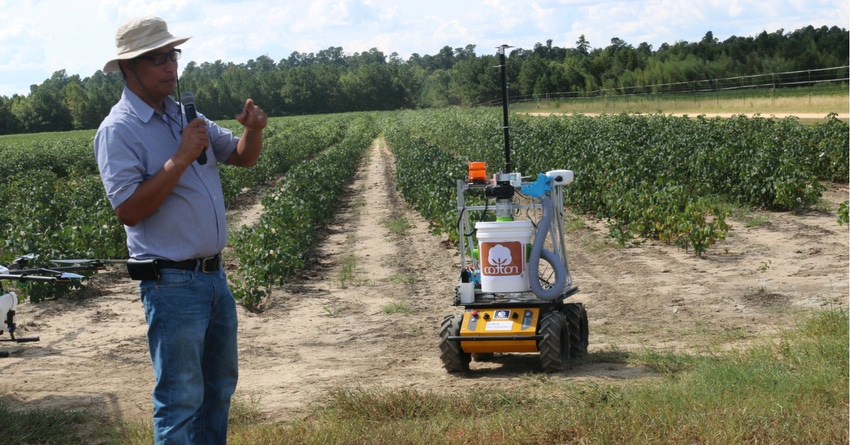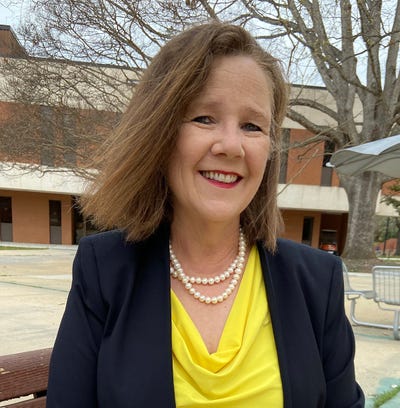
The agricultural workforce is shrinking and some Clemson University researchers believe robots may help provide a means to protect America’s food and fiber industries.
A group of them studying the use of robots in agriculture recently met with researchers from other universities and representatives from Clearpath Robotics to learn about programs and hardware that are available to equip robots to work in agricultural crops.
“Robots are becoming more integrated into the manufacturing industry,” said Joe Mari Maja, a research sensor engineer at Clemson’s Edisto Research and Education Center. “Though most of the manufacturing environment is not as complicated as the outdoor environment, recent advances on sensors and technology provide an interesting outlook on how robots will be working outdoors with humans.”
Using small unmanned ground vehicles (UGV) or mobile ground robots with navigation sensing provides a platform to increase farm management efficiency, Maja said. The platform can be retrofitted with different components to perform specific tasks, such as spraying, scouting, remote-sensing, quantifying plant properties and harvesting.
Maja is studying how to use a robot for selective cotton harvesting and weeding. He and his staff retrofitted a robot with a vacuum-type system with a small storage bin and believes having a robotic cotton harvester would be a great help for cotton farmers.
“The cotton harvester robot was successfully assembled and tested on a field within the first three months of its development,” Maja said. “Several adjustments, calibrations, reconfigurations and tests will be conducted to help us improve this technology so that it can be used.”
The United States is the third largest cotton-producing country in the world, behind India and China. To move ahead of India and China, American cotton farmers must be able to increase production efficiency while reducing labor costs. Using cotton harvesting machines is one way farmers can reduce labor costs and still pick cotton as soon as the bolls open. Robotic cotton harvesters are expected to cost less than traditional farm equipment. Harvesting machines can cost as much as $700,000, compared to an anticipated $4,000 for robotic cotton harvester prototypes.
“It is envisioned that a new UGV will be developed with the prototype for less than $10,000,” Maja said, bringing the total cost of the robotic cotton harvester to about $14,000.
Other researchers agree robots may have a place in agriculture, but these robots must be easy to operate and repair.
“Big machines are getting more difficult to repair,” said John Heun, a University of Arizona precision agriculture engineer. “If robots are open and have schematics that can easily be repaired, I believe they will be more accepted for use in agriculture. The system needs to be open so that they can easily be accessed.”
Edward Barnes of Cotton Incorporated, a collaborator on the Clemson Cotton Robotics project, agrees. The Clemson Cotton Robotics project is funded by Cotton Incorporated and is exploring the development of a mobile robot platform for cotton harvesting.
“Rapid repair and ease of access are important,” Barnes said. “I believe cotton harvest is a potential application for robots, but more research needs to be done. Farmers aren’t computer programmers, so they will need someone to run their computers to operate the robots. There are still some questions that need to be answered.”
In addition to harvesting cotton, Barnes believes robots also will be used to simplify the ginning process.
Using robots to fill the labor gap in agriculture may be what is needed to help provide food and fiber Americans need and help farmers stay productive.
Adam Kantrovich, Clemson Cooperative Extension Service agribusiness professor at the Sandhill Research and Education Center, said there are a number of variables playing a role in the labor shortage, including: age, wages, benefits, work environment and temporary or seasonal employment vs. permanent employment in some agricultural areas.
“It is important to note that farmers are not price-makers,” Kantrovich said. “They must take the price offered for their products by the market. This leaves them with little to no margins in many cases to be able to pay all their bills, including for taxes, for any debts, such as pay the bank for loans, let alone for them to put food on the table.”
Source: Clemson University, which is solely responsible for the information provided and is wholly owned by the source. Informa Business Media and all its subsidiaries are not responsible for any of the content contained in this information asset.
About the Author(s)
You May Also Like






